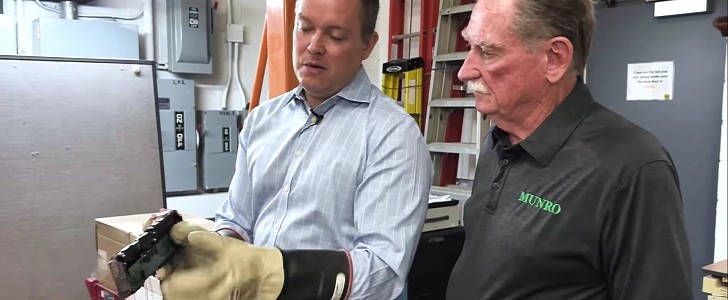As Munro & Associates started disassembling the structural battery pack with 4680 cells in the Tesla Model Y, we’ve followed their progress, however small. Now it’s time to get to the bottom of it as Sandy Munro prepares to call it a day and move on.
When teardown firm Munro & Associates started to disassemble the structural battery pack of the Tesla Model Y, the team had no idea that this would prove such a tedious job. It took them two weeks to take the battery lead off, but what they found inside was even more baffling. The battery cells and other critical components were all engulfed in a pink polyurethane foam that was as strong as a brick.
After another week, Sandy and his team removed the polyurethane foam using a dry ice blaster and got to see what was inside for the first time. In a new video, Sandy Munro is ready to tell us his thoughts about the Tesla Model Y’s structural battery. Together with Cory Steuben, Munro discusses different components of the battery pack, including the battery management system (BMS), voltage sensor harness (VSH) attachment, and current collector welds.
While this is merely a recap of all the work done until now, Sandy Munro stresses the different solutions used by Tesla engineers to improve the battery pack. For instance, Tesla moved to use direct connections between the cells and the collector plates. By ditching the small wire bonds used in the 2170 packs, the battery’s internal resistance improves, allowing higher currents to flow in both directions without causing heat buildup. Not to mention eliminating one of the weak points, as wire welding can sometimes be a hit and miss.
Another interesting thing is that the team only found 16 little threaded fasteners in the entire pack, which is highly unusual. As Sandy pointed out a while back, fasteners are also prone to assembly errors, so Tesla eliminating another weak point is a good thing. To further minimize installation errors, Tesla uses color-coded parts with no-nonsense markings. The colors used are easily distinguishable even by color-blind people.
Munro & Associates will prepare a more thorough report on every design choice and material used in the structural battery pack and the 4680 battery cells. They even intend to make a like-for-like comparison with the 2170-based battery pack, which should be interesting. We’ll be looking forward to finding out more.
After another week, Sandy and his team removed the polyurethane foam using a dry ice blaster and got to see what was inside for the first time. In a new video, Sandy Munro is ready to tell us his thoughts about the Tesla Model Y’s structural battery. Together with Cory Steuben, Munro discusses different components of the battery pack, including the battery management system (BMS), voltage sensor harness (VSH) attachment, and current collector welds.
While this is merely a recap of all the work done until now, Sandy Munro stresses the different solutions used by Tesla engineers to improve the battery pack. For instance, Tesla moved to use direct connections between the cells and the collector plates. By ditching the small wire bonds used in the 2170 packs, the battery’s internal resistance improves, allowing higher currents to flow in both directions without causing heat buildup. Not to mention eliminating one of the weak points, as wire welding can sometimes be a hit and miss.
Another interesting thing is that the team only found 16 little threaded fasteners in the entire pack, which is highly unusual. As Sandy pointed out a while back, fasteners are also prone to assembly errors, so Tesla eliminating another weak point is a good thing. To further minimize installation errors, Tesla uses color-coded parts with no-nonsense markings. The colors used are easily distinguishable even by color-blind people.
Munro & Associates will prepare a more thorough report on every design choice and material used in the structural battery pack and the 4680 battery cells. They even intend to make a like-for-like comparison with the 2170-based battery pack, which should be interesting. We’ll be looking forward to finding out more.








